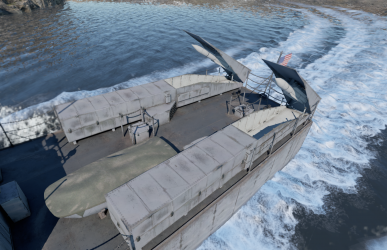RIM-24A

Contents
Description
The RIM-24A is an American surface-to-air missile. It was introduced in Update "Danger Zone"
Vehicles equipped with this weapon
General info
The RIM-24A, also known as the Tartar missile, is a surface-to-air missile system that was developed by the United States Navy during the Cold War era. It was first deployed in the early 1960s and was used extensively during the Vietnam War to defend U.S. Navy ships from enemy aircraft.
The Tartar missile system was a significant improvement over previous systems in terms of range, speed, and accuracy. It was able to engage targets at a range of up to 50 miles and had a top speed of Mach 2.5. The system used semi-active radar guidance to track and intercept enemy aircraft, which made it highly effective in combat situations.
| Missile Characteristics | |
|---|---|
| Mass | 580 kg |
| Guidance | Semi-Automatic (SACLOS) |
| Launch range | 14.00 km |
| Maximum speed | 620 m/s |
| Missile guidance time | 30.0 secs |
| Explosive type | Torpex |
| Explosive mass | 30.8 kg |
| TNT equivalent | 49.28 kg |
| Warhead type | SAP-HE |
Effective damage
Describe the type of damage produced by this type of missile (high explosive, splash damage, etc)
Comparison with analogues
Give a comparative description of missiles that have firepower equal to this weapon.
Usage in battles
Describe situations when you would utilise this missile in-game (vehicle, pillbox, base, etc)
Pros and cons
Pros:
- Extreme acceleration and speed
- Average manoeuvrability
Cons:
- Using the missile at sort range is impossible
- Can damage critically only unarmoured ships
History
During World War II, the United States Navy recognized that there was a significant gap in their air defense umbrella. The role of short-range air defense was a changing selection of guns starting with the AN-M2 Browning machine guns before moving up to the 20 mm/70 Oerlikon cannons and the Bofors L/60 Mark 1. Long-Range air defense, meanwhile, was handled by fighter aircraft, but there was a gap in the field of medium-range air defense. The gap was first noticed in 1943 with the effectiveness of the Luftwaffe (German Air Force) Henschel Hs 293 and Fritz X guided anti-ship bombs against American naval vessels in the Mediterranean.
In response, Operation Bumblebee was launched to develop a ramjet-powered surface-to-air missile that could fill the gap between guns and fighters. The end result of the ramjet-powered missile was the RIM-8 Talos adopted in 1958, but three years prior, the RIM-2 Terrier was developed as a testbed for the program before getting adopted. The RIM-2 is the basis for the RIM-24A Tartar which is the last of the designs collectively called the "3T" missiles that emerged from Operation Bumblebee.
The RIM-24A was developed as a smaller version of the Terrier for use on smaller naval warships and for engaging targets at a closer range than its larger cousin. The design for the Tartar was effectively a RIM-2C without the secondary booster and was adopted in 1962 by the United States Navy. Used dual and single-arm mounts, the RIM-24A Tartar was the primary weapon of several destroyers including the Charles F. Adams, the guided missile conversions of the Mitscher and Forrest Sherman-classes along with the Brooke-class frigates in the United States Navy. It was the secondary armament for the Albany-class missile cruisers. It was also used in foreign navies in the Koninklijke Marine (Royal Netherlands Navy), Marine Nationale (French Navy), the Royal Australian Navy, the Japanese Maritime Self-Defense Force, the Marina Militare (Italian Navy), Bundesmarine (German Navy) and Royal Australian Navy.
The RIM-24A Tartar is a semi-active radar-homing design with a 130-pound missile warhead, a top speed of Mach 1.8, and a range of 8.7 nautical miles (10 miles). The RIM-24A was found to be an unreliable design, however, so the design was upgraded to the RIM-24B Improved Tartar and later the RIM-24A missiles were subjected to the RIM-24C Improved Tartar Retrofit (ITR). The RIM-24 would have its development ended after the adoption of the improved RIM-66 Standard missile adopted in 1967 though the Tartar missile would continue to serve into the 1980s.
Media
Excellent additions to the article would be video guides, screenshots from the game, and photos.
See also
Links to the articles on the War Thunder Wiki that you think will be useful for the reader, for example:
- reference to the article about the variant of the weapon;
- references to approximate analogues by other nations and research trees.
External links
Paste links to sources and external resources, such as:
- topic on the official game forum;
- other literature.
| Naval special armaments | |
|---|---|
| USA | |
| Mortars | 7.2-inch T37 · Mk 2 |
| Rockets | 5-inch GPSR Mk.7 · Mark 108 Weapon alfa |
| Missiles | RIM-24A |
| Germany | |
| Rockets | M/50 Bofors |
| Missiles | Strela-2M |
| USSR | |
| Mortars | BM-37 · RBM · RBU-1200 · RBU-2500 · RBU-6000 · RKU-36U |
| Rockets | BM-14-17 · BM-21 · M13 · M-8 |
| Missiles | Volna-M |
| Britain | |
| Mortars | Ordnance ML 4.2-inch mortar |
| Japan | |
| Rockets | 4.5-inch BBR Mk.7 (USA) · Mark 108 Weapon alfa (USA) |
| Italy | |
| Missiles | Nettuno |



